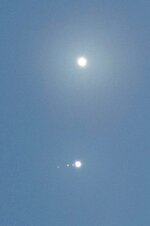lpetrich
Contributor
The European Space Agency's Jupiter Icy Moons Explorer is on its way -- ESA's Juice spacecraft.
ESA - ESA’s Juice lifts off on quest to discover secrets of Jupiter’s icy moons - launched atop an Ariane 5 rocket from the Kourou spaceport in French Guiana at 14:14 CEST on 14 April.
 Jupiter Icy Moons Explorer and ESA - Juice
Jupiter Icy Moons Explorer and ESA - Juice
The spacecraft will use a gravity-assist trajectory:
The spacecraft will be powered by solar panels and it will contain several instruments:
ESA - ESA’s Juice lifts off on quest to discover secrets of Jupiter’s icy moons - launched atop an Ariane 5 rocket from the Kourou spaceport in French Guiana at 14:14 CEST on 14 April.
The spacecraft will use a gravity-assist trajectory:
- 2023 Apr - launch
- 2024 Aug - Earth flyby 1
- 2025 Aug - Venus flyby
- 2026 Sep - Earth flyby 2
- 2029 Jan - Earth flyby 3
- 2031 Jul - Arrival at Jupiter
- Some 35 flybys of Jupiter's moons Europa, Ganymede, and Callisto, those icy moons
- 2034 Dec - Entry into orbit around Ganymede
- 2035 Sep - End of mission: crash into Ganymede
The spacecraft will be powered by solar panels and it will contain several instruments:
- Jovis, Amorum ac Natorum Undique Scrutator (JANUS) -- Latin: "comprehensive observation of Jupiter, his love affairs and descendants." -- optical camera
- Moons and Jupiter Imaging Spectrometer (MAJIS) -- visual and near-infrared
- UV Imaging Spectrograph (UVS)
- Sub-millimeter Wave Instrument (SWI)
- Ganymede Laser Altimeter (GALA)
- Radar for Icy Moons Exploration (RIME)
- JUICE-Magnetometer (J-MAG)
- Particle Environment Package (PEP) -- for Jupiter's magnetosphere
- Radio and Plasma Wave Investigation (RPWI)
- Gravity and Geophysics of Jupiter and Galilean Moons (3GM) -- uses a radio transponder and an ultrastable oscillator
- Planetary Radio Interferometer and Doppler Experiment (PRIDE)

